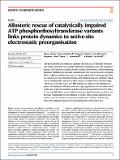Allosteric rescue of catalytically impaired ATP phosphoribosyltransferase variants links protein dynamics to active-site electrostatic preorganisation
Abstract
ATP phosphoribosyltransferase catalyses the first step of histidine biosynthesis and is controlled via a complex allosteric mechanism where the regulatory protein HisZ enhances catalysis by the catalytic protein HisGS while mediating allosteric inhibition by histidine. Activation by HisZ was proposed to position HisGS Arg56 to stabilise departure of the pyrophosphate leaving group. Here we report active-site mutants of HisGS with impaired reaction chemistry which can be allosterically restored by HisZ despite the HisZ:HisGS interface lying ~20 Å away from the active site. MD simulations indicate HisZ binding constrains the dynamics of HisGS to favour a preorganised active site where both Arg56 and Arg32 are poised to stabilise leaving-group departure in WT-HisGS. In the Arg56Ala-HisGS mutant, HisZ modulates Arg32 dynamics so that it can partially compensate for the absence of Arg56. These results illustrate how remote protein-protein interactions translate into catalytic resilience by restoring damaged electrostatic preorganisation at the active site.
Citation
Fisher , G , Corbella , M , Alphey , M S , Nicholson , J , Read , B , Kamerlin , S C L & da Silva , R G 2022 , ' Allosteric rescue of catalytically impaired ATP phosphoribosyltransferase variants links protein dynamics to active-site electrostatic preorganisation ' , Nature Communications , vol. 13 , 7607 . https://doi.org/10.1038/s41467-022-34960-9
Publication
Nature Communications
Status
Peer reviewed
ISSN
2041-1723Type
Journal article
Description
Funding: This work was supported by the Biotechnology and Biological Sciences Research Council (BBSRC) [Grant BB/M010996/1] via EASTBIO Doctoral Training Partnership studentships to B. J. R. and G. F., by Stiftelsen Olle Engkvist Byggmästare [Grant 190-0335] and the Knut and Alice Wallenberg Foundation [Grants 2018.0140 and 2019.0431] to S.C.L.K., and by the European Union’s Horizon 2020 Research and Innovation Programme via a Marie Sklodowska-Curie fellowship [Grant 890562] to M.C. The simulations were enabled by resources provided by the Swedish National Infrastructure for Supercomputing (SNIC, UPPMAX), partially funded by the Swedish Research Council [Grant 2016-07213].Collections
Items in the St Andrews Research Repository are protected by copyright, with all rights reserved, unless otherwise indicated.

